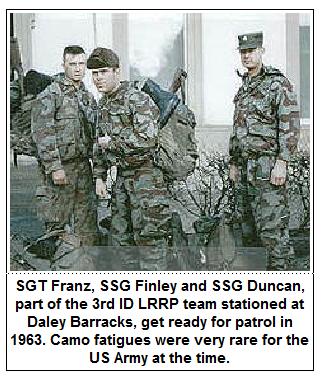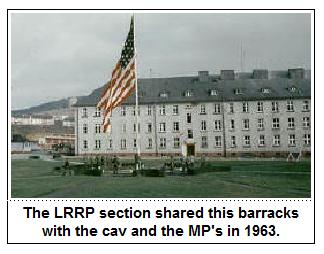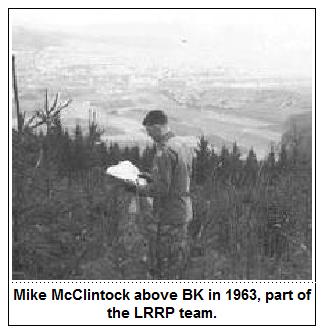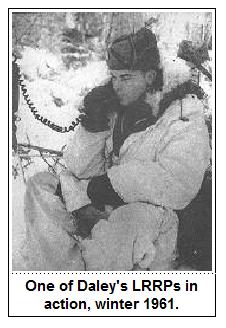| |
The 2/14 Cav and the 3rd ID LRRPs
We would like to thank Mr. Emmit W. Hiltibrandt of the 75th Ranger
Association for permission to use this text and Mr. Mike McClintock for
further help with details and photos that help tell the story.
In the early 1960's, the Long Range Recon Patrol section of the 3rd
Infantry Division was co-located with the 2/14 ACR at Daley Barracks.
The section shared the squadron barracks and mess hall; and while the
"sneak and peek" training of the LRRPs and the mounted shock and
firepower of a cavalry squadron seemed to be from opposite ends of the
recon textbook, nevertheless, they co - existed and developed a mutual
respect.
Here is the story:
3rd Infantry Division Long Range Recon Patrol (LRRP) Detachment
This is an abbreviated history of the 3rd Infantry Division Long Range
Reconnaissance Patrol (LRRP) Detachment during the period of its
existence from 20 November 1961 to 14 August 1964. This history also
includes reference to a predecessor unit, the provisional V Corps Long
Range Patrol Co. established in October 1960.

The history of U.S. Army's Long Range Recon Patrols in Germany
evolved from NATO's development of the concept in the late 1950s. This
concept was influenced by the British Special Air Service's (SAS)
successful use of small independently operating deep reconnaissance
patrols. Among the first such U.S. Army units to be activated in Germany
was USAREUR's (U.S. Army Europe) V Corps Long Range Patrol. This unit
was initially a TDY unit comprised of highly motivated volunteers from
various units of the 3rd Infantry Division and the 3rd Armored Division.
The unit was organized in October 1960 for the specific purpose of
providing Corps level long-range intelligence from behind enemy lines.
The upcoming Wintershield II maneuvers were to provide both a test of
the feasibility of the concept and to evaluate its effectiveness. The
success of this unit in the Wintershield II exercises led to the formal
establishment of the V Corps (ABN) LRRP Co. at Wildflecken on 15 July
1961. This unit ultimately became Company A (Airborne Ranger), 75th
Infantry.
The 3rd Infantry Division LRRP Detachment had its roots in the
provisional V Corps LRRP Co. formed for the Wintershield II operation
and the Division's Battle Group (Battalion) level LRRP units. Among
these were LRRP detachments from the 2d BG, 4th Infantry and the 1st BG,
15th Infantry stationed at Warner Kaserne in Bamberg. The members of
these units formed the nucleus for the first division-level LRRP
detachment in the U.S. Army, and, as with the British SAS, were all
volunteers and were "returned to unit" if found unsuited for duty in a
special operations environment.
The 3rd Infantry Division Long Range Recon Patrol (LRRP) Detachment was
formed on 20 November 1961 with 1LT Edward M. Jentz as Detachment
Commander. 1LT Jentz was an Airborne Ranger from the 1st Battle Group,
30th Infantry in Schweinfurt. The Detachment's Operations Officer was
1LT John H. Peyton from the 3rd Infantry Division's Security Platoon in
Wurzburg. 1LT Peyton was also an Airborne Ranger.
The unit's First Sergeant was SFC Gerald M. "Mike" Tardif. SFC Tardif
was also an Airborne Ranger who had served previously with the Canadian
Army. The unit's operations NCO was SSG Robert H. Schroeder. SSG
Schroeder ("Red Dog") was a master parachutist and instructor at the
Army's Ranger School at Fort Benning for nine years prior to being sent
to Germany. Bob Schroeder had jumped into Nijmegen, Holland on D-Day
1944 with the 82d Airborne Division and had served in the Korean War.
His experiences as both a combat veteran and as a Ranger instructor set
very high standards for the unit. Other Airborne Rangers forming part of
the initial detachment were SGTs Clifford N. Mize, Bobby Freeman, and
SFC Bobby McMeans. SGT Mize was a hand-to-hand combat instructor from
the Ranger School and was later killed in Vietnam. SFC McMeans had
served with the 10th Mountain Division. SGT Freeman had also served with
the provisional V Corps LRRP Co. and returned to that unit in 1962. The
3rd Inf. Div. LRRP Detachment was based at Daley Barracks in the
Northern Bavarian resort town of Bad Kissingen, approximately 60 miles
east of Frankfurt and about 20 miles from the E. German border. It was
attached to the 10th Engineer Battalion in Wurzburg for logistical and
administrative support. The unit was originally billeted with troops of
the 2d Squadron of the 14th Armored Cavalry Regiment. The Cav troops
weren't sure who these crazy "Lurps" were, who got up and ran several
miles every day regardless of the weather, even in deep snow. The fact
that the unit wore distinctive German Army camouflage uniforms and
carried rucksacks instead of standard issue web gear only heightened the
Cav's interest. The unit also wore a distinctive, but unauthorized "Long
Range Patrol" scroll on its headgear.
The Berlin Wall had gone up in August of 1961, and international
tensions were quite high. It was a time of great danger between NATO and
the Warsaw Pact, and everyone knew that if the Russians started World
War III, the unit's chances of survival were slim to none. Hence,
everyone concentrated on learning everything they needed to know to
enhance their chances of survival. As a result, the men's confidence
grew and they took pride in being a part of an elite unit. This pride
was reflected in the detachment's motto:
"May the fires of Hell forever crackle and smell with the meat and the
bones of a thing called a man who says, I can't!"
As a consequence of this esprit de corps, the unit was extremely
cohesive, and in this regard would have been a good subject for a case
study in small unit leadership, i.e., unit members were motivated to
accomplish the mission because of positive, as opposed to negative
stimuli. In other words, the men were motivated to get the job done with
the highest degree of efficiency because they wanted to, not because
they were coerced or forced.
The unit's training reflected its mission: to act as the eyes and
ears of the Division behind enemy lines and to observe enemy movements,
pinpoint targets, and report back to Division Intelligence. In addition
to its rigorous physical training program, the unit practiced patrolling
(both day and night), map reading and land navigation, forward observer
techniques, cover and concealment, explosives and demolitions, rock
climbing and rapelling, escape and evasion, path finding and helicopter
operations, hand-to-hand combat, CBR, first aid, and the recognition and
identification of Soviet Bloc uniforms and equipment. The unit also
underwent 6 weeks of intensive radio and morse code (CW) training at the
123d Signal Battalion's radio school in Wurzburg. During the course the
detachment was taught how to operate CW (Morse Code) on the AN/GRC-9,
AN/GRC-41, and AN/GRC-26 radios. The students also learned defense
against jamming, communications security, and field radio maintenance
procedures. The men also learned how to set up the radios in the field
and how to orient and string the "long wire" antenna.
At the height of its proficiency, the detachment lost Captain Jentz and
1LT Peyton to the 10th Special Forces Group in Bad Tolz. This was just
before the detachment was scheduled to deploy on its first major field
training exercise. SSG Bob Schroeder was the NCOIC of the detachment
during this interim period and directed the unit's deployment on the FTX.
The exercise was a huge success, with the Lurps providing real time
intelligence on "enemy" troop movements and concentrations for the first
time in the Division's recent history.
The unit's second commanding officer was 1LT Wilbur G. Bowersox. 1LT
Bowersox was also an Airborne Ranger who was assigned to the unit in
late-1962. During 1LT Bowersox's tenure as CO, the detachment continued
its rigorous training schedule and participated in numerous FTXs and war
games, often playing the role of aggressors or guerrillas. Most of these
missions involved helicopter insertions behind "enemy" lines with 3-4
man patrols.

These patrols typically consisted of a patrol leader, radio operator,
asst. radio operator, and a scout observer. On a 3-man patrol, the
patrol leader usually acted as the radio operator (as the assistant had
to hand-crank the AN/GRC-9's generator). Early on, the patrol leaders
were all E-6s and E-7s, but as these career soldiers "derossed," SP/4s
and PFCs became patrol leaders. These young EM were also experienced
soldiers, many with over two years time in grade, but who were passed
over for promotion by their TO&E units because of their detached duty
status. Many top notch soldiers went home as E-3s because they chose to
remain with the detachment. Such was the level of pride and camaraderie
among the LRRPs of the 3rd Infantry Division. It was also during this
period that the unit's name was changed to the "Marne Scouts Recon
Patrol (MSRP)." No one really cared for this name, but the unit bore it
proudly knowing all the while they were still Lurps!
In late 1963 both 1LT Bowersox and SSG Schroeder rotated back to the
States. SSG Schroeder was sorely missed by the remaining members of the
detachment. His replacement as First Sergeant was a SSG Turner who was
assigned to the unit from Division HQ. SSG Turner was a good soldier,
but was not Airborne or Ranger qualified, and the unit's training
activities and field operations diminished accordingly.
The detachment's third and last CO, 2LT John A. Walden joined the unit
at the end of 1963. 2LT Walden was an Airborne Ranger, but by this time
the Division had other plans for the unit. The Year 1964 was spent
mostly in garrison duty, with only some opportunities for LRRP actions,
most notably along the E. German Border with the 14th AC. In June 1964,
the detachment participated in a 100-mile march to Nijmegen, Holland to
commemorate the 20th anniversary of D-Day. The unit also led the
Division in the Expert Infantry Badge (EIB) competition, with most of
the detachment earning the coveted award. SGT Dalton Naill achieved the
highest overall score in the Division, and was awarded a large trophy in
addition to the EIB. SSG Don Rampanelli scored second highest in the
Division and also received an award.

On August 14, 1964 the 3rd Infantry Division Long Range Recon Patrol was
disbanded and its troops returned to their TO&E units. Several men
offered to extend their tours for duty with the V Corps and VII Corps
LRRP Companies, but were turned down by their TO&E unit commanders as
being too valuable to be let go.
Although the 3rd Infantry Division LRRP Detachment never served in
combat, it nonetheless trained hard, often in extreme weather
conditions, and was arguably one of the finest units in the U.S. Army of
its era. Even though it was disbanded over 33 years ago, the unit still
exists today in the hearts and memories of the 100 or so men who served
with it during its short existence. Among those memories is that of the
unit's disbandment party, which, even by Lurp standards, was one hell of
a party!
In August 1997, twenty-six former members of the unit, along with wives
and guests, attended the detachment's first reunion in Columbus,
Georgia. Ceremonies were held at the Ranger Memorial at Fort Benning to
honor former LRRP/Ranger comrades who have made their last patrol.
During a Friday evening banquet held at the historic Columbus Hilton
Hotel, COL Ed Jentz (Ret.), LTC John H. Peyton (Ret.), CSM Mike Tardif
(Ret.) and MSG Robert H. Schroeder (Ret.) received awards from the
detachment recognizing their commitment to the unit and honoring their
leadership. After more than 30 years we still remember and revere these
old warriors, and appreciate the sacrifices made by them and those who
came after us, and who continue the Lurp/Ranger tradition today.
And that's the way it was in the 3rd Infantry Division LRRPs. |
|